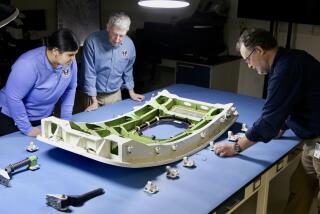Space Shuttle’s Wing Cracks During Test With Foam Block
- Share via
SAN ANTONIO — Columbia investigators obtained their first direct evidence in a test Friday that foam debris caused the space shuttle accident: a foam block fired at a wing panel left a three-inch crack.
Engineers used a powerful gas gun to shoot a 1.6-pound foam block at a replica of Columbia’s left wing, damaging the delicate heat shield on the leading edge.
Such damage may explain how a breach opened, allowing superheated gases to enter the wing and melt the aluminum structure.
The foam, shot at 768 feet per second, or about 530 miles per hour, also dislodged the leading edge panel by about one-tenth of an inch and opened a slightly larger gap than is normal along one side of the panel and slightly smaller on the other side.
The board had previously indicated that it believes foam debris fell off the shuttle’s external tank 82 seconds after launch and struck the leading edge of the wing, which is constructed of a material called reinforced carbon carbon, or RCC.
Investigators for the Columbia Accident Investigation Board said the test results represent an important step in their efforts to solve the Feb. 1 accident when the Columbia broke up over east Texas.
“This is the first evidence that a piece of foam that approximates what was observed in the accident can crack and damage a piece of flight RCC panel,” said Scott Hubbard, a member of the investigation board.
The test culminated months of careful planning that had been put on hold Thursday by a Texas thunderstorm and again Friday morning when an electrical circuit malfunctioned.
After a dramatic countdown to zero, nothing happened and workers had to partially disassemble the gun.
By early afternoon, the gun was back together and precisely aimed with a laser. After another countdown, the gun let loose with a loud whoosh followed by a thunderclap of the impact.
The foam slammed into the slate-gray wing with a force of 4,500 pounds -- enough to kill a person. It sent puffs of foam dust and sprayed larger chunks across the test site.
The leading edge panel used for the test Friday was taken from the shuttle Discovery and had flown into space on 30 missions, similar to the flight history of Columbia. It cost an estimated $775,000 to make in the 1980s.
Paul Fischbeck, an engineering professor at Carnegie Melon University who has helped conduct independent studies of the shuttle’s thermal protection system, said the results of the test are “very revealing.”
“It is quite remarkable that foam could do that to an RCC panel,” he said. “To me, that is phenomenal. Six months ago, nobody would have believed that foam could crack an RCC panel.”
Although the leading edge panel sustained a serious crack that would disqualify it from any flight into space, the foam test did not provide conclusive evidence that such a crack would have created a flight hazard, Hubbard said.
Until now, investigators were looking for a gap or breach in the leading edge that would have allowed superheated gases an entry into the wing’s interior. It could take days of technical analysis to fully assess whether the cracks observed Friday could have led to a subsequent breach during reentry.
“We have some of the world’s top reinforced carbon carbon experts here, and they are scratching their heads and wondering what it means,” Hubbard said. “They are not sure this crack would be sufficient to cause the entry of hot gases.”
A number of investigators had been anticipating more dramatic damage to the wing, perhaps a large hole or disintegration of the panel, given the results of a similar test two weeks ago when foam was shot at a leading edge panel made of fiberglass.
The fiberglass was dislodged and permanently deformed.
More to Read
Sign up for Essential California
The most important California stories and recommendations in your inbox every morning.
You may occasionally receive promotional content from the Los Angeles Times.











